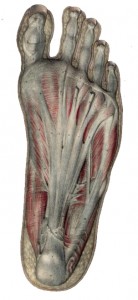Unilateral Rolling of the Foot did not Affect Non-Local Flexibility or Balance
A study has demonstrated that unilateral foot rolling (using a roller) did not improve ROM of the ankle, hamstring flexibility, or low back ROM in the ipsilateral or contralateral limb. In addition, unilateral foot rolling also did not affect postural balance. This is in contrast with previous studies in which the quadriceps, hamstrings, and plantarflexors were rolled and both non-local ipsilateral and non-local crossover contralateral effects were found in musculature that was not rolled.
The team from Canada and Germany published in Journal of Sports Science and Medicine investigated if unilateral foot rolling would affect ipsilateral and contralateral measures of ROM and balance in young healthy adults. A randomized within-subject design was used to examine non-local effects of unilateral foot rolling on ipsilateral and contralateral limb ankle dorsiflexion ROM and a modified sit-and-reach-test (SRT) that was used as a measure of hamstring flexibility and low back ROM. Static balance was also tested with a 30-second single-leg stance test.
Twelve participants performed three sets of 60-second unilateral plantar sole rolling using a foot roller on the dominant foot with 60-second rest intervals between sets. ROM and balance measures were assessed in separate sessions at pre-intervention, immediately post-intervention, and 10 minutes post-intervention. To evaluate repeated measures effects, two SRT pre-tests were implemented. Results demonstrated that the second pre-test SRT was 6.6% higher than the first pre-test. There were no statistically significant effects of foot rolling on any measures immediately post-intervention or 10 minutes post-intervention.
The important findings of this study indicated that unilateral plantar sole rolling showed no statistically significant effects on ankle joint dorsiflexion ROM, hamstring flexibility, or lower back ROM. Secondly, the intervention did not change static balance performance.
It is also interesting to note that the first pre-intervention assessment of the SRT was significantly different than the second pre-intervention SRT assessment. This highlights the methodological importance of implementing multiple pre-intervention assessments.
The authors speculated that their “non-significant” findings might be attributed to a lower degree of roller-induced afferent stimulation due to the smaller volume of myofascia tissue found in the plantar foot as compared to prior studies that rolled the quadriceps, hamstrings, and plantarflexors, all musculature with greater volume of myofascial tissue. Furthermore, the authors added that ROM results from studies utilizing only a single pre-test should be viewed critically.
Of further note, it would be interesting if this study also compared the effect of bilateral foot rolling instead of only unilateral foot rolling.

